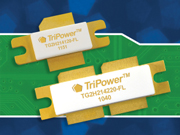
| Home | About Us | Contribute | Bookstore | Advertising | Subscribe for Free NOW! |
| News Archive | Features | Events | Recruitment | Directory |
News
1 February 2010
TriQuint’s new TriPower GaAs HV-HBT RF transistors offer 55% efficiency for 3G/4G base-station amplifiers
RF product maker and foundry services provider TriQuint Semiconductor Inc of Hillsboro, OR, USA has released the first products in its new, high-efficiency ‘green’ TriPower family of high-power 3G/4G wireless base-station RFICs. The firm says that TriPower devices allow network operators to address the top two challenges of rapidly growing consumer demand for bandwidth-hungry smartphones and similar products: reducing the electricity needed to power network base-station amplifiers, while allowing operators to more easily increase network capacity and speed.
The name ‘TriPower’ is derived from three primary benefits: high power, high efficiency and high linearity. A more efficient amplifier translates into savings, says TriQuint. For example, for a system with 2000 such amplifiers (as might be used to cover one medium-sized city and surrounding area), a TriPower-based network could cut CO2 emissions by about 340 tons each year compared with the efficiency of amplifiers typically deployed currently, reckons the firm (equivalent of adding more than 130 acres of trees to the ecosystem, since each acre of trees absorbs about 2.6 tons of CO2 annually according to the US Forestry Service).
 “The complex modulation requirements of 3G and 4G networks cannot be delivered efficiently by legacy semiconductor technologies,” says TriQuint Networks VP, Brian P. Balut. “TriQuint examined the potential for both types of devices [gallium arsenide (GaAs) and gallium nitride (GaN)] in high-power base-station applications. We believe that — for reasons of reliability, cost and efficiency — TriPower’s GaAs HV-HBT [high-voltage heterojunction bipolar transistor] technology is the best choice,” he adds.
“The complex modulation requirements of 3G and 4G networks cannot be delivered efficiently by legacy semiconductor technologies,” says TriQuint Networks VP, Brian P. Balut. “TriQuint examined the potential for both types of devices [gallium arsenide (GaAs) and gallium nitride (GaN)] in high-power base-station applications. We believe that — for reasons of reliability, cost and efficiency — TriPower’s GaAs HV-HBT [high-voltage heterojunction bipolar transistor] technology is the best choice,” he adds.
TriQuint employs a proprietary GaAs HV-HBT process, design and manufacturing techniques to achieve TriPower’s efficiency performance. TriPower RFICs can also be easily linearized using conventional digital pre-distortion (DPD) techniques, Balut explains. TriPower products offer wireless base-station makers and network operators a much-desired efficiency improvement while meeting the linearity requirements of 3G/4G cellular systems. “TriPower devices provide the greatest reduction in power consumption available on the market today and can enable new, highly efficient, tower-mounted remote radio head designs,” he claims.
Researchers at the University of California at San Diego (UCSD) have compared key base-station amplifier technologies including silicon LDMOS, GaN and TriPower GaAs HV-HBT technology. Lead researcher, professor Donald Kimball, concluded in the paper ‘High Efficiency WCDMA Envelope Tracking Base Station Amplifier Implemented with GaAs HVHBTs’ (published in November 2008) that TriPower devices offer a clear efficiency advantage. The devices deliver what is claimed to be a record 55% efficiency for reduced electricity demand and smaller carbon footprints, compared with average efficiency approaching 42% in existing systems.
“There has been a vigorous competition between different transistor technologies for the highest efficiency in base-station amplifiers,” says Kimball. “HV-HBT is the greenest device for base-station radios,” Kimball comments. “It will make a significant difference for power reduction in future systems, including ones in remote areas with limited prime power availability.”
When used in a symmetric Doherty amplifier application for maximum efficiency boost, two TriQuint TG2H214120 120W devices can deliver over 60W of average WCDMA power with 55% efficiency. Due to TriPower's very high efficiency, operators can place larger amplifiers onto existing cell site towers without a corresponding increase in size or weight, TriQuint reckons. Higher-power amplifiers, in turn, deliver higher data rates to all users in the cell.
“Any technology that can increase overall efficiency of the RF power amplifier, such as TriPower from TriQuint, will allow the industry to meet the more stringent energy requirements for high PAR (peak-to-average ratio) amplifiers going forward,” believes Earl J. Lum, president of EJL Wireless Research LLC. “Through 2013, higher-PAR multi-mode 3G WCDMA/HSPA and 4G LTE base stations will rapidly replace legacy 2G GSM for BTS (base transceiver station) shipments and will increase in market share from 25% to over 50% of the market,” he forecasts. “On a unit basis, shipments of high-PAR amplifiers for base stations will dramatically increase 85% on an annual basis from 2008 through 2013.”
TriQuint’s TriPower device family will be exhibited at the GSMA Mobile World Congress in Barcelona, Spain (15–18 February). The latest TriPower products are being designed into new generations of 3G/4G base stations, says the firm. TriQuint’s two new high-efficiency TriPower devices, [TG2H214120 (120W) and TG2H214220 (220W)] are the first in a series of products that will include more frequency bands and power levels in 2010 and beyond. The new devices aim to expand the ‘green’ impact of TriPower technology globally to different cellular systems.
![]() Search: TriQuint GaAs HBT Base-station amplifiers
Search: TriQuint GaAs HBT Base-station amplifiers
Visit: www.triquint.com/tripower
Visit: www.mwc2010.triquint.com